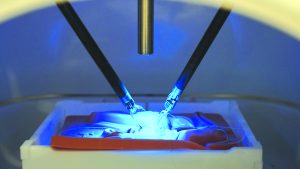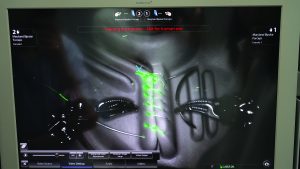
Justin Opferman, a mechanical engineering PhD student in the IMERSE Lab, watches a monitor in Hackerman Hall’s mock operating room. On the screen, he observes as his colleague Yaning Wang carefully stitches two pieces of synthetic tissue together using the da Vinci robotic surgical system.
Wang guides the two robotic forceps as they pass a clear suture back and forth, threading it through the pink rubber. But with a couple of taps on the monitor to change the camera settings, Opfermann demonstrates that this is no ordinary suture. Everything on the screen turns black and white except for the stitches, which glow bright green.
The fluorescent suture is part of Glow and Sew, a tool Opfermann and his partners Wang and Jiawei Ge are developing to help surgeons improve outcomes in a surgical procedure known as anastomosis that involves joining two tubes together. This surgery can be challenging, especially when there’s blood in the surgical field or the tissue folds in on itself, making the suture difficult to see and leading to less-than-perfect sewing.
“It’s very difficult, but you need to be perfect at it 100% of the time to stop a complication,” such as sepsis, from occurring, Opfermann explains.
 Unlike typical sutures, the Glow and Sew suture is coated in a fluorescent powder that glows under near-infrared light, which is also able to penetrate through the blood and tissue, allowing surgeons to always see where their stitches are. “It essentially is giving you a superhuman capability to see something that’s normally hidden in the surgical process,” Opfermann says.
Unlike typical sutures, the Glow and Sew suture is coated in a fluorescent powder that glows under near-infrared light, which is also able to penetrate through the blood and tissue, allowing surgeons to always see where their stitches are. “It essentially is giving you a superhuman capability to see something that’s normally hidden in the surgical process,” Opfermann says.
Opfermann came up with the idea for Glow and Sew with the help of Axel Krieger, PhD ’08, an associate professor of mechanical engineering, and Simon Leonard, assistant research professor in computer science, around five years ago. But it wasn’t until earlier this year that he was able to test his idea, thanks to funding from the Whiting School’s Student Initiatives Fund. Glow and Sew received $2,500 in support to buy supplies, develop and test initial concepts, and create a working prototype that the team can use to secure additional funding.
Next, Opfermann aims to find a way to incorporate artificial intelligence and machine learning to create overlays that show surgeons where each stitch should go. He plans to use the data from this research to apply for patents and other grants with the goal of bringing his ideas into actual operating rooms to improve patient outcomes.




